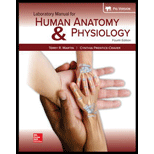
The __________ is a skull bone that is not interlocked along sutures.
- mandible
- maxilla
- temporal bone
- occipital bone
Introduction:
The skeletal structure supporting the formation of the head and guards the brain is known as skull or cranium. The cranium or skull is further divided into facial bones and cranial bones. A suture is a fibrous joint that is present in the skull.
Answer to Problem 1PL
Correct answer:
The correct answer is option (a) mandible.
Explanation of Solution
Explanation/justification for the correct answer:
Option (a) mandible. The cranial system consists of a total of 22 bones. Among which 8 bones are of cranium and 14 bones are facial bones. The mandible comes under facial bone. It is the lower jaw in humans. Mandible is the largest bone of the facial skeleton and is not joined by any suture. Therefore, this is the correct answer.
Explanation for incorrect answer:
Option (b) Maxilla. Maxilla is a part of the facial skeleton and forms the upper jaw in humans. It is composed of two maxillary bones that are joined by intermaxillary suture, and form anterior nasal spine. Therefore, this is an incorrect answer.
Option (c) Temporal bone. It is a part of the 8 cranium bones that form the sidewalls of the skull. Temporal bone is connected to other bones of the skull by different sutures such as squamosal suture that connects temporal bone with lower border of the parietal bone and occipitomastoid suture that joins the temporal bone with the occipital bone. Therefore, this is an incorrect answer.
Option (d) Occipital bone. It is one of the 8 bones of the cranium that forms its lower back area. It is trapezoidal-shaped. Occipital bone fuses with parietal bone through lambdoid suture. And mastoid portion of the temporal bone and occipital bone is fused through occipitomastoid suture. Therefore, this is an incorrect answer.
Thus, option (a) mandible that forms the lower jaw is a skull bone that is not interlocked along sutures.
Want to see more full solutions like this?
Chapter 14 Solutions
Laboratory Manual For Human Anatomy & Physiology
Additional Science Textbook Solutions
Chemistry & Chemical Reactivity
Physical Science
Biological Science (6th Edition)
Genetics: From Genes to Genomes
Campbell Biology in Focus (2nd Edition)
- Describe the principle of homeostasis.arrow_forwardExplain how the hormones of the glands listed below travel around the body to target organs and tissues : Pituitary gland Hypothalamus Thyroid Parathyroid Adrenal Pineal Pancreas(islets of langerhans) Gonads (testes and ovaries) Placentaarrow_forwardWhat are the functions of the hormones produced in the glands listed below: Pituitary gland Hypothalamus Thyroid Parathyroid Adrenal Pineal Pancreas(islets of langerhans) Gonads (testes and ovaries) Placentaarrow_forward
- Describe the hormones produced in the glands listed below: Pituitary gland Hypothalamus Thyroid Parathyroid Adrenal Pineal Pancreas(islets of langerhans) Gonads (testes and ovaries) Placentaarrow_forwardPlease help me calculate drug dosage from the following information: Patient weight: 35 pounds, so 15.9 kilograms (got this by dividing 35 pounds by 2.2 kilograms) Drug dose: 0.05mg/kg Drug concentration: 2mg/mLarrow_forwardA 25-year-old woman presents to the emergency department with a 2-day history of fever, chills, severe headache, and confusion. She recently returned from a trip to sub-Saharan Africa, where she did not take malaria prophylaxis. On examination, she is febrile (39.8°C/103.6°F) and hypotensive. Laboratory studies reveal hemoglobin of 8.0 g/dL, platelet count of 50,000/μL, and evidence of hemoglobinuria. A peripheral blood smear shows ring forms and banana-shaped gametocytes. Which of the following Plasmodium species is most likely responsible for her severe symptoms? A. Plasmodium vivax B. Plasmodium ovale C. Plasmodium malariae D. Plasmodium falciparumarrow_forward
- please fill in missing parts , thank youarrow_forwardplease draw in the answers, thank youarrow_forwarda. On this first grid, assume that the DNA and RNA templates are read left to right. DNA DNA mRNA codon tRNA anticodon polypeptide _strand strand C с A T G A U G C A TRP b. Now do this AGAIN assuming that the DNA and RNA templates are read right to left. DNA DNA strand strand C mRNA codon tRNA anticodon polypeptide 0 A T G A U G с A TRParrow_forward
 Medical Terminology for Health Professions, Spira...Health & NutritionISBN:9781305634350Author:Ann Ehrlich, Carol L. Schroeder, Laura Ehrlich, Katrina A. SchroederPublisher:Cengage LearningUnderstanding Health Insurance: A Guide to Billin...Health & NutritionISBN:9781337679480Author:GREENPublisher:Cengage
Medical Terminology for Health Professions, Spira...Health & NutritionISBN:9781305634350Author:Ann Ehrlich, Carol L. Schroeder, Laura Ehrlich, Katrina A. SchroederPublisher:Cengage LearningUnderstanding Health Insurance: A Guide to Billin...Health & NutritionISBN:9781337679480Author:GREENPublisher:Cengage Anatomy & PhysiologyBiologyISBN:9781938168130Author:Kelly A. Young, James A. Wise, Peter DeSaix, Dean H. Kruse, Brandon Poe, Eddie Johnson, Jody E. Johnson, Oksana Korol, J. Gordon Betts, Mark WomblePublisher:OpenStax College
Anatomy & PhysiologyBiologyISBN:9781938168130Author:Kelly A. Young, James A. Wise, Peter DeSaix, Dean H. Kruse, Brandon Poe, Eddie Johnson, Jody E. Johnson, Oksana Korol, J. Gordon Betts, Mark WomblePublisher:OpenStax College





